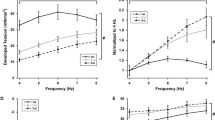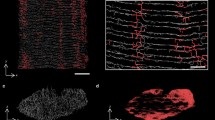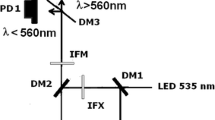Abstract
The exposure of amphibian muscle to osmotic shock through the introduction and subsequent withdrawal of extracellular glycerol causes ‘vacuolation’ in the transverse tubules. Such manoeuvres can also electrically isolate the transverse tubules from the surface (‘detubulation’), particularly if followed by exposures to high extracellular [Ca2+] and/or gradual cooling. This study explored factors influencing vacuolation in Rana temporaria sartorius muscle. Vacuole formation was detected using phase contrast microscopy and through the trapping or otherwise of lissamine rhodamine dye fluorescence within such vacuoles. The preparations were also examined using electron microscopy, for penetration into the transverse tubules and tubular vacuoles of extracellular horseradish peroxidase introduced following the osmotic procedures. These comparisons distinguished for the first time two types of vacuole, ‘open’ and ‘closed’, whose lumina were respectively continuous with or detached from the remaining extracellular space. The vacuoles formed close to and between the Z-lines, but subsequently elongated along the longitudinal axis of the muscle fibres. This suggested an involvement of tubular membrane material; the latter appeared particularly concentrated around such Z-lines in the electron-micrograph stereopairs of thick longitudinal sections. ‘Open’ vacuoles formed following osmotic shock produced by extracellular glycerol withdrawal from a glycerol-loaded fibre at a stage when one would expect a net water entry to the intracellular space. This suggests that vacuole formation requires active fluid transport into the tubular lumina in response to fibre swelling. ‘Closed’ vacuoles only formed when the muscle was subsequently exposed to high extracellular [Ca2+] and/or gradual cooling following the initial osmotic shock. Their densities were similar to those shown by ‘open’ vacuoles in preparations not so treated, suggesting that both vacuole types resulted from a single process initiated by glycerol withdrawal. However, vacuole ‘closure’ took place well after formation of ‘open’ vacuoles, over 25 min after glycerol withdrawal. Its time course closely paralleled the development of detubulation reported recently. It was irreversible, in contrast to the reversibility of ‘open’ vacuole formation. These findings identify electrophysiological ‘detubulation’ of striated muscle with ‘closure’ of initially ‘open’ vacuoles. The reversible formation of open vacuoles is compatible with some normal membrane responses to some physiological stresses such as fatigue, whereas irreversible formation of closed vacuoles might only be expected in pathological situations as in dystrophic muscle.
Similar content being viewed by others
References
ADRIAN, R. H. & PEACHEY, L. D. (1973) Reconstruction of the action potential of frog sartorius muscle. J. Physiol. 235, 103–31.
AYETTEY, A. S. & NAVARATNAM, V. (1978) The T-tubule system in the specialized and general myocardium of the rat. J. Anat. 127, 125–40.
CAPUTO, C. (1968) Volume and twitch tension changes in single muscle fibres in hypertonic solutions. J. Gen. Physiol. 52, 793–809.
DULHUNTY, A. F. & GAGE, P. W. (1973) Differential effects of glycerol treatment on membrane capacity and excitation contraction coupling in skeletal muscle. J. Physiol. 234, 373–408.
EISENBERG, R. S., HOWELL, J. N. & VAUGHAN, P. C. (1971) The maintenence of resting potentials in glyceroltreated muscle fibres. J. Physiol. 215, 95–102.
ENDO, M. (1966) Entry of fluorescent dyes into the sarcotubular system of the frog muscle. J. Physiol. 185, 224–38.
ERVASTI, J. M. & CAMPBELL, K. P. (1993) Dystrophin and the membrane skeleton. Curr. Opin. Cell Biol. 5, 82–7.
FONG, P., TURNER, P. R., DENETCLAW, W. F. & STEINHARDT, R. A. (1990) Increased activity of calcium leak channels in myotubes of Duchenne human and mdx mouse origin. Science 250, 673–6.
FRANCO, A. & LANSMAN, J. B. (1990) Calcium entry through stretch-inactivated ion channels in mdx myotubes. Nature 344, 670–73.
FRANCO-OBREGON, A. & LANSMAN, J. B. (1994) Mechanosensitive ion channels in skeletal muscle from normal and dystrophic mice. J. Physiol. 481, 299–309.
FRANZINI-ARMSTRONG, C., HEUSER, J. E., REESE, T. S., SOMLYO, A. P. & SOMLYO, A. V. (1978) T-tubule swelling in hypertonic solutions: a freeze substitution study. J. Physiol. 283, 133–40.
FRANZINI-ARMSTRONG, C., VENOSA, R. A. & HOROWICZ, P. (1973) Morphology and accessibility of the ‘transverse’ tubular system in frog sartorius muscle after glycerol treatment. J. Membrane Biol. 14, 197–212.
GAGE, P. W. & EISENBERG, R. S. (1969a) Capacitance of the surface and transverse tubular membrane of frog sartorius muscle fibers. J. Gen. Physiol. 53, 265–78.
GAGE, P. W. & EISENBERG, R. S. (1969b) Action potentials, afterpotentials and excitation-contraction coupling in frog sartorius fibers without transverse tubules. J. Gen. Physiol. 53, 298–310.
GALLAGHER, F. A. & HUANG, C. L.-H. (1997) Osmotic detubulation in frog muscle arises from a reversible vacuolation process. J. Muscle Res. Cell Motil. 18, 305–22.
GONZALEZ-SERRATOS, H., SOMLYO, A. V., McCLELLAN, G., SHUMAN, H., BORRERO, L. M. & SOMLYO, A. P. (1978) Composition of vacuoles and sarcoplasmic reticulum in fatigued muscle: electron probe analysis. Proc. Natl Acad. Sci. USA 75, 1329–33.
HOWELL, J. N. (1969) A lesion of the transverse tubules of skeletal muscle. J. Physiol. 201, 515–33.
HOWELL, J. N. & JENDEN, D. J. (1967) T-tubules of skeletal muscle: morphological alterations which interrupt excitation-contraction coupling. Fed. Proc. 26, 553.
HUANG, C. L.-H. (1993) Intramembrane Charge Movements in Striated Muscle. Monographs of the Physiological Society, No. 44. Oxford: Clarendon Press.
HUANG, C. L.-H. & PEACHEY, L. D. (1989) Anatomical distribution of voltage-dependent membrane capacitance in frog skeletal muscle fibres. J. Gen. Physiol. 93, 565–84.
HUANG, C. L.-H. & PEACHEY, L. D. (1992) A reconstruction of charge movement during the action potential in frog skeletal muscle. Biophys. J. 61, 1133–46.
HUTTER, O. F., BURTON, F. L. & BOVELL, D. L. (1991) Mechanical properties of normal and mdx mouse sarcolemma: bearing on function of dystrophin. J. Muscle Res. Cell Motil. 12, 585–9.
KOENIG, M., MONACO, A. P. & KUNKEL, L. M. (1988) The complete sequence of dystrophin predicts a rod-shaped cytoskeletal protein. Cell 53, 219–28.
KOUTSIS, G., PHILIPPIDES, A. & HUANG, C. L.-H. (1995) The afterdepolarization in Rana temporaria muscle fibres following osmotic shock. J. Muscle Res. Cell Motil. 16, 519–28.
KROLENKO, S. A. (1969) Changes in the T-system of muscle fibres under the influence of influx and efflux of glycerol. Nature 221, 966–8.
KROLENKO, S. A., AMOS, W. B. & LUCY, J. A. (1995) Reversible vacuolation of the transverse tubules of frog skeletal muscle: a confocal fluorescence microscopy study. J. Muscle Res. Cell Motil. 16, 401–11.
LANNERGREN, J. & WESTERBLAD, H. (1991) Force decline due to fatigue and intracellular acidification in isolated fibres from mouse skeletal muscle. J. Physiol. 434, 307–22.
LEW, V., HOCKADAY, A., FREEMAN, C. & BOOKCHIN, R. (1988) Mechanism of spontaneous inside-out vesiculation of red cell membranes. J. Cell Biol. 106, 1893–1901.
LIBELIUS, R., JIRMANOVA, I., LUNDQUIST, I., THESLEFF, S. & BARNARD, E. A. (1979) T-tubule endocytosis in dystrophic chicken muscle and its relation to muscle fiber degeneration. Acta Neuropathologica 48, 31–8.
MALOUF, N. N. & WILSON, P. F. (1986) Proliferation of the surface connected intracytoplasmic membranous network in skeletal muscle disease. Am. J. Pathol. 125, 358–68.
MENKE, A. & JOCKUSCH, H. (1991) Decreased osmotic stability of dystrophin-less muscle cells from the mdx mouse. Nature 349, 69–71.
NAKAJIMA, S., NAKAJIMA, Y. & PEACHEY, L. D. (1973) Speed of repolarization and morphology of glyceroltreated frog muscle fibres. J. Physiol. 234, 465–80.
PADMANABHAN, N. & HUANG, C. L.-H. (1990) Separation of tubular electrical activity in amphibian skeletal muscle through temperature change. Exp. Physiol. 75, 721–4.
PASTERNAK, C., WONG, S. & ELSON, E. (1995) Mechanical function of dystrophin in muscle cells. J. Cell. Biol. 128, 355–61.
PEACHEY, L. D. & EISENBERG, B. R. (1978) Helicoids in the T-system and striations of frog skeletal muscle fibres seen by high voltage electron microscopy. Biophys. J. 22, 145–54.
TURNER, P. R., FONG, P., DENETCLAW, W. F. & STEINHARDT, R. A. (1991) Increased calcium influx in dystrophic muscle. J. Cell. Biol. 115, 1701–12.
TURNER, P. R., SCHULTZ, R., GANGULY, B. & STEINHARDT, R. A. (1993) Proteolysis results in altered leak channel kinetics and elevated free calcium in mdx muscle. J. Memb. Biol. 133, 243–51.
ZACHAR, J., ZACHAROVA, D. & ADRIAN, R. H. (1972) Observations on ‘detubulated’ muscle fibres. Nature 239, 153–5.
ZUBRZYCKA-GAARN, E. E., BULMAN, D. E., KARPATI, G., BURGHES, A. H. M., BELFALL, B., KLAMUT, H. J., TALBOT, J., HODGES, R. S., RAY, P. N. & WORTON, R. G. (1988) The Duchenne muscular dystrophy gene product is localized in the sarcolemma of human skeletal muscle. Nature 333, 466–9.
Rights and permissions
About this article
Cite this article
Fraser, J.A., Skepper, J.N., Hockaday, A.R. et al. The tubular vacuolation process in amphibian skeletal muscle. J Muscle Res Cell Motil 19, 613–629 (1998). https://doi.org/10.1023/A:1005325013355
Issue Date:
DOI: https://doi.org/10.1023/A:1005325013355




